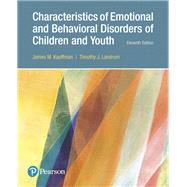NOTE: Used books, rentals, and purchases made outside of Pearson
If purchasing or renting from companies other than Pearson, the access codes for the Enhanced Pearson eText may not be included, may be incorrect, or may be previously redeemed. Check with the seller before completing your purchase.
This package includes the Enhanced Pearson eText and the bound book.
A coherent conceptualization of the problems of students with Emotional and Behavioral Disorders (EBD) and their challenges for teachers.
The Eleventh Edition of Characteristics of Emotional and Behavioral Disorders of Children and Youth follows the text's long-standing reputation for trusted research, a teacher-focused presentation, and clear explanations of the concepts related to students with Emotional and Behavioral Disorders (EBD). Organized around major concepts in four logical parts, the text helps readers understand the background of EBD, the origins of behavior disorders, the types of behavior disorders, and the procedures associated with the assessment of these disorders. The teacher-focused presentation offers a sound conceptualization of the problems that students with EBD encounter and the common challenges for their teachers. Case studies, Personal Reflections, and Questions for Reflection features launch readers into self-questioning and prompt them to think critically about behavior and its contexts. This edition includes new references, new Personal Reflections, reorganized chapters for a more effective flow of content, and more detailed coverage of assessment.
Improve mastery and retention with the Enhanced Pearson eText*
The Enhanced Pearson eText provides a rich, interactive learning environment designed to improve student mastery of content. The Enhanced Pearson eText is:
Engaging. The new interactive, multimedia learning features were developed by the authors and other subject-matter experts to deepen and enrich the learning experience.
Convenient. Enjoy instant online access from your computer or download the Pearson eText App to read on or offline on your iPad® and Android® tablet.*
Affordable. Experience the advantages of the Enhanced Pearson eText along with all the benefits of print for 40% to 50% less than a print bound book.
*The Enhanced eText features are only available in the Pearson eText format. They are not available in third-party eTexts or downloads.
*The Pearson eText App is available on Google Play and in the App Store. It requires Android OS 3.1-4, a 7” or 10” tablet, or iPad iOS 5.0 or later.
0134460618 / 9780134460611 Characteristics of Emotional and Behavioral Disorders of Children and Youth, with Enhanced Pearson eText -- Access Card Package
Package consists of:
0134449908 / 9780134449906 Characteristics of Emotional and Behavioral Disorders of Children and Youth
0134573714 / 9780134573717 Characteristics of Emotional and Behavioral Disorders of Children and Youth, Enhanced Pearson eText -- Access Card








